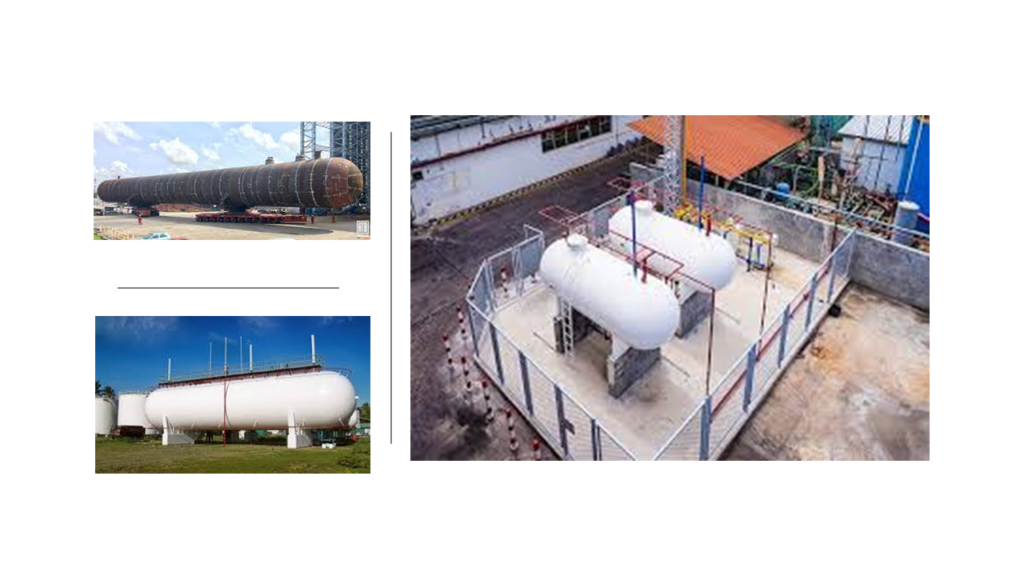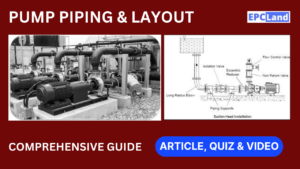1. Introduction
Bullet tanks, also known as bullet vessels or bullet storage tanks, are a crucial component of various industries, offering efficient and safe storage solutions for liquids and gases. These tanks are characterized by their cylindrical shape with rounded ends, resembling the shape of a bullet. This unique design optimizes space utilization and offers distinct advantages in terms of maintenance and safety. This article delves into the components of bullet tanks, their design considerations, applications, adherence to codes and standards, safety considerations, comparison with other storage types, and future trends.
Table of Contents
Do not miss the detailed course on Tank Farm Layout & Stress Analysis
Enrollment link
Check out Similar Articles on other Storage Tanks
2. Bullet Tank Components
Bullet tanks consist of several key components that ensure their structural integrity and operational functionality.
Shell: The primary cylindrical body of the tank provides structural support and contains the stored substance.
Roof and Roof Structures: The rounded roof of the bullet tank prevents the accumulation of rainwater and provides additional strength to the tank. It may include support structures such as rafters or trusses.
Nozzles and Manholes: These openings allow for the inlet and outlet of substances, as well as maintenance and inspection.
Support Structures: The tank is supported by legs, skirts, or saddles, which transfer the weight to the foundation.
Safety Features: Bullet tanks are equipped with safety features like relief valves and rupture discs that release pressure to prevent over-pressurization.
Accessories: These include level indicators, temperature sensors, and gauges for monitoring substance levels and conditions.

Table 1: Tank Components with Descriptions
| Component | Description |
|---|---|
| Shell | Primary cylindrical body of the tank. |
| Roof and Structures | Rounded roof preventing water accumulation and adding structural strength. |
| Nozzles and Manholes | Openings for substance inlet/outlet, inspection, and maintenance. |
| Support Structures | Legs, skirts, or saddles supporting the tank and transferring weight to the foundation. |
| Safety Features | Relief valves, rupture discs releasing pressure to prevent over-pressurization. |
| Accessories | Level indicators, temperature sensors, and gauges for monitoring substance levels and conditions. |
Do not miss the detailed course on Tank Farm Layout & Stress Analysis
Enrollment link
3. Design and Construction
The design of bullet tanks involves several considerations to ensure structural integrity, safety, and efficiency.
Design Considerations: Bullet tanks are designed to withstand the pressures and loads exerted by the stored substances. Factors such as substance properties, external forces, seismic conditions, and wind loads influence the design.
Manufacturing Materials and Methods: Tanks are commonly constructed using steel due to its strength and durability. Welding is the primary method of fabrication, and materials are chosen based on substance compatibility.
Welding Techniques and Non-Destructive Testing: Welding ensures the tank’s structural integrity. Non-destructive testing methods, such as radiography and ultrasonic testing, are employed to identify potential defects.
Table 2: Pros and Cons of Bullet Tanks
| Aspect | Pros | Cons |
|---|---|---|
| Advantages | Efficient space utilization | Limited capacity compared to other tank types |
| Lower maintenance requirements | Challenging maintenance due to height | |
| Suitable for various substances | ||
| Disadvantages | Higher initial manufacturing costs | |

Do not miss the detailed course on Tank Farm Layout & Stress Analysis
Enrollment link
4. Applications of Bullet Tanks
Bullet tanks find applications across diverse industrial sectors due to their advantages.
Industrial Sectors: Industries such as agriculture, chemical, oil and gas, and food processing utilize bullet tanks for storage needs.
Storage of Liquids and Gases: Bullet tanks are used to store a wide range of substances, including liquids like water, oil, and chemicals, as well as gases such as propane and ammonia.
Table 3: Applications of Bullet Tanks with Examples
| Industry | Applications | Examples |
|---|---|---|
| Agriculture | Fertilizer storage | Ammonium nitrate storage for farming |
| Chemical | Chemical storage | Storage of various industrial chemicals |
| Oil and Gas | Crude oil storage | Storage of crude oil at oil refineries |
| Food Processing | Liquid food storage | Bulk storage of cooking oils |
5. Codes and Standards
Adherence to industry codes and standards is crucial to ensure the safety and reliability of bullet tanks.
Industry Standards: Bullet tanks are designed and manufactured following standards such as API 620 and API 650, which outline design, fabrication, and inspection requirements.
ASME Boiler and Pressure Vessel Code: This code provides guidelines for the design, construction, inspection, and testing of pressure vessels, including bullet tanks.
Compliance with Safety Regulations: Bullet tanks must comply with safety regulations to prevent accidents and ensure the protection of personnel and the environment.
Table 4: Key Codes and Standards for Bullet Tanks
| Code/Standard | Description |
|---|---|
| API 620 and API 650 | Design, fabrication, and inspection standards |
| ASME Boiler and Pressure Vessel Code | Guidelines for pressure vessel design and safety |
6. Safety Considerations
Safety is paramount in bullet tank design and operation to prevent accidents and leaks.
Importance of Safety: Proper design, maintenance, and adherence to safety standards are vital to prevent leaks, explosions, and other accidents.
Risk Assessment and Hazard Analysis: Conducting thorough risk assessments and hazard analyses helps identify potential dangers and implement preventive measures.
Past Accidents and Lessons Learned: Learning from past accidents, such as the 2005 Texas City refinery explosion, underscores the need for strict safety measures and continuous improvement.
Table 5: Past Accidents, Causes, and Lessons Learned
| Accident | Causes | Lessons Learned |
|---|---|---|
| 2005 Texas City refinery explosion | Lack of safety procedures, communication | Emphasize safety, communication protocols |
| failures, inadequate training | Regular safety training and drills |
Do not miss the detailed course on Tank Farm Layout & Stress Analysis
Enrollment link
7. Environmental Impact
Bullet tanks have environmental implications that must be addressed.
Environmental Concerns: Leaks from bullet tanks can lead to soil and water contamination, necessitating spill containment and cleanup measures.
Spill Containment and Response Strategies: Implementing spill containment systems and response plans reduces the impact of leaks.
Comparison with Other Storage Methods: Comparing bullet tanks with aboveground and underground storage highlights their benefits and drawbacks.
Table 6: Environmental Impact and Mitigation Measures
| Environmental Aspect | Impact | Mitigation Measures |
|---|---|---|
| Spill Contamination | Soil and water contamination from leaks | Spill containment systems, rapid response plans |
| Comparison with Other Storage Methods | Varies based on storage type | Choose storage method based on substance and site conditions |
8. Comparison with Other Storage Types
Bullet tanks are often compared with other storage types, such as spherical and cylindrical tanks.
Bullet Tanks vs. Spherical Tanks: Bullet tanks are more space-efficient, while spherical tanks distribute stress more evenly.
Bullet Tanks vs. Cylindrical Tanks: Bullet tanks require less ground space, but cylindrical tanks offer greater capacity.
Factors Influencing Choice: Factors like site constraints, substance properties, and capacity needs influence the choice between tank types.
Table 7: Comparison between Bullet, Spherical, and Cylindrical Tanks
| Aspect | Bullet Tanks | Spherical Tanks | Cylindrical Tanks |
|---|---|---|---|
| Space Efficiency | High | Lower | Moderate |
| Capacity | Limited | High | High |
| Stress Distribution | Concentrated at ends | Uniform | Concentrated at bottom |
| Site Constraints | Suitable for compact sites | Requires more space | Moderate space requirements |
Do not miss the detailed course on Tank Farm Layout & Stress Analysis
Enrollment link
9. Conclusion
Bullet tanks play a pivotal role in various industries by providing efficient storage solutions for liquids and gases. Their unique design, components, and safety features make them indispensable for applications ranging from agriculture to chemical processing. Adherence to codes and standards, coupled with a strong focus on safety and environmental considerations, ensures their reliable and secure operation. As industries continue to evolve, the future of bullet tanks lies in technological advancements, improved materials, and sustainable practices, ensuring their continued significance in the storage landscape.
10. FAQs
1. What are bullet tanks used for?
Answer: Bullet tanks are used for storing various substances, both liquids and gases. They find applications in industries such as agriculture, chemical, oil and gas, and food processing. They are particularly suitable for storing substances like oil, chemicals, propane, ammonia, and water.
2. How do bullet tanks differ from other types of storage tanks?
Answer: Bullet tanks are distinct in their cylindrical shape with rounded ends, resembling the shape of a bullet. This design optimizes space utilization and is suitable for compact sites. In comparison, spherical tanks distribute stress more evenly, and cylindrical tanks offer higher capacity. The choice between tank types depends on factors like space availability, substance properties, and capacity needs.
3. What safety measures are in place for bullet tanks?
Answer: Bullet tanks are equipped with safety features such as relief valves and rupture discs that release pressure to prevent over-pressurization. They are designed and manufactured following industry standards like API 620 and API 650, which outline design, fabrication, and inspection requirements. Adherence to safety regulations and regular risk assessments help prevent accidents and ensure personnel and environmental safety.
4. What environmental considerations are associated with bullet tanks?
Answer: Bullet tanks can have environmental implications if leaks occur, leading to soil and water contamination. Spill containment systems and response plans are essential to mitigate the impact of leaks. It’s important to compare bullet tanks with other storage methods, considering factors like spill contamination potential and the environmental impact of different types of tanks.
5. What is the future outlook for bullet tanks?
Answer: The future of bullet tanks involves emerging technologies such as automation and remote monitoring systems, which enhance safety and operational efficiency. Additionally, advancements in materials science contribute to the durability and resistance to corrosion of bullet tanks. Sustainable practices, including environmental considerations in design and operation, will continue to shape the evolution of bullet tanks in industries seeking more eco-friendly solutions.
Recommended courses (Published on EPCLand)
- Basics of Piping Engineering
- Piping Layout Engineering
- Piping Material Engineering
- Piping Stress Analysis
- Complete Course on Piping Engineering
- Material Requisitions
- Piping Material Specifications
- Valve Material Specifications
Don’t miss the published articles on following:
Related Video
Attempt Quiz
Question 1:
What are bullet tanks commonly used for?
Explanation: Bullet tanks are commonly used for storing liquid petroleum gases (LPG), such as propane and butane, which are used as fuels and refrigerants.
Question 2:
What is a distinctive feature of bullet tanks?
Explanation: A distinctive feature of bullet tanks is their cylindrical shape, which allows them to efficiently store and transport pressurized liquids like LPG.
Question 3:
Which material is commonly used for constructing bullet tanks?
Explanation: Steel is a commonly used material for constructing bullet tanks due to its strength, durability, and ability to withstand the pressures and conditions associated with storing LPG.
Question 4:
What is the primary safety concern when using bullet tanks?
Explanation: The primary safety concern when using bullet tanks is the potential for excessive pressure inside the tank, which can lead to leaks, ruptures, or other hazardous situations if not properly managed.
Question 5:
What is the purpose of safety relief valves on bullet tanks?
Explanation: Safety relief valves on bullet tanks are designed to release excess pressure and prevent over-pressurization, ensuring the safe operation of the tank and preventing potential hazards.


